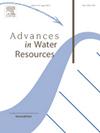Sub-daily precipitation returns levels in ungauged locations: Added value of combining observations with convection permitting simulations
IF 4
2区 环境科学与生态学
Q1 WATER RESOURCES
引用次数: 0
Abstract
Extreme rainfall events trigger natural hazards, including floods and debris flows, posing serious threats to society and the economy. Accurately quantifying extreme rainfall return levels in ungauged locations is crucial for improving flood protection infrastructure and mitigating water-related risks. This paper quantifies the added value of combining rainfall observations with Convection Permitting Model (CPM) simulations to estimate sub-daily extreme rainfall return levels in ungauged locations. We assess the performance of CPM-informed estimates of extreme return level against a traditional interpolation techniques. We find that kriging methods with external drift outperform inverse distance weighting for both traditional and CPM-informed approaches. We then assess the effectiveness of the two methods under different scenarios of station density. At the highest station density (1/196 km²), traditional interpolation methods outperform the CPM-informed method for durations under 6 h. The performance becomes comparable between 6 and 24 h. For lower station densities (1/400 and 1/800 km²), the CPM-informed method outperforms the traditional method, with average reductions in fractional standard error of 24 %, 13 %, and 8 % for return periods of 2, 10 and 50 years, respectively for a rain gauge density of 1/800 km², and 16 %, 8 %, and 3 % for density of 1/400 km². Information from CPM simulations can thus be useful for estimating sub-daily extreme rainfall events in ungauged sites, particularly in data-scarce areas in which the density of rain gauges is low.
无测站地点的次日降水回报水平:观测与对流许可模拟相结合的附加价值
极端降雨事件会引发洪水和泥石流等自然灾害,对社会和经济造成严重威胁。准确量化无测站地区的极端降雨重现水平对于改善防洪基础设施和降低与水有关的风险至关重要。本文量化了将降雨观测与对流许可模型(CPM)模拟相结合,估算无测站地区次日极端降雨重现水平的附加值。我们对照传统的插值技术,评估了以对流许可模型为依据估算的极端回归水平的性能。我们发现,在传统方法和以 CPM 为依据的方法中,带有外部漂移的克里金方法都优于反距离加权法。然后,我们评估了这两种方法在不同台站密度情况下的有效性。在台站密度最高的情况下(1/196 平方公里),传统插值方法在 6 小时以内的性能优于 CPM-有信息方法。对于较低的站点密度(1/400 和 1/800 km²),CPM-informed 方法优于传统方法,对于重现期为 2 年、10 年和 50 年的雨量计密度为 1/800 km²的站点,平均分数标准误差分别减少 24%、13% 和 8%;对于密度为 1/400 km²的站点,平均分数标准误差分别减少 16%、8% 和 3%。因此,CPM 模拟得出的信息可用于估算无雨量计地点的次日极端降雨事件,特别是在雨量计密度较低的数据稀缺地区。
本文章由计算机程序翻译,如有差异,请以英文原文为准。
求助全文
约1分钟内获得全文
求助全文
来源期刊

Advances in Water Resources
环境科学-水资源
CiteScore
9.40
自引率
6.40%
发文量
171
审稿时长
36 days
期刊介绍:
Advances in Water Resources provides a forum for the presentation of fundamental scientific advances in the understanding of water resources systems. The scope of Advances in Water Resources includes any combination of theoretical, computational, and experimental approaches used to advance fundamental understanding of surface or subsurface water resources systems or the interaction of these systems with the atmosphere, geosphere, biosphere, and human societies. Manuscripts involving case studies that do not attempt to reach broader conclusions, research on engineering design, applied hydraulics, or water quality and treatment, as well as applications of existing knowledge that do not advance fundamental understanding of hydrological processes, are not appropriate for Advances in Water Resources.
Examples of appropriate topical areas that will be considered include the following:
• Surface and subsurface hydrology
• Hydrometeorology
• Environmental fluid dynamics
• Ecohydrology and ecohydrodynamics
• Multiphase transport phenomena in porous media
• Fluid flow and species transport and reaction processes
 求助内容:
求助内容: 应助结果提醒方式:
应助结果提醒方式:


